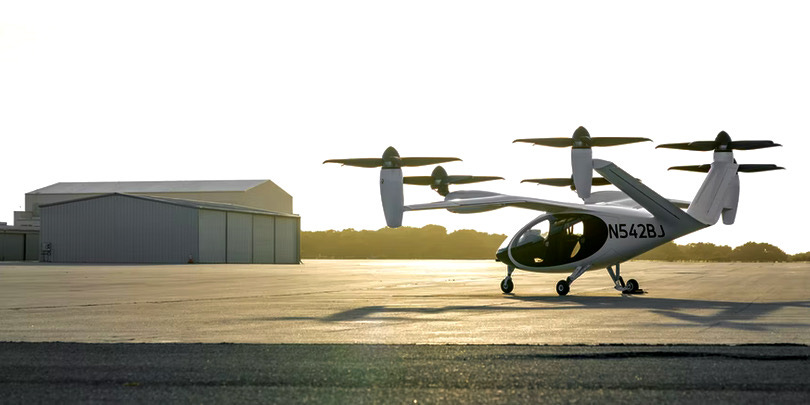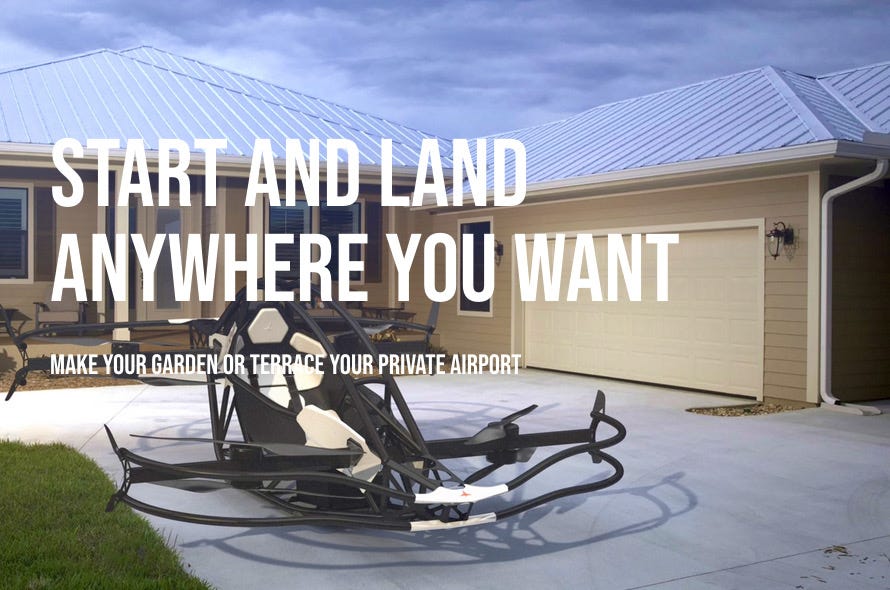Electric flying ‘cars’ in race toward takeoff
Big advances make battery powered flight more than a mere fantasy
The idea of personal flying vehicles began as an animated science fantasy in the 1960s. Today, they are closer than ever to becoming science fact.
The first “flying car” appeared in the popular imagination in ‘The Jetsons’ sitcom about 60 years ago.
Today, dozens of start-ups are working to make them a reality – and they’re a lot further along than most realize.
The most promising concept is the electric vertical takeoff and landing vehicle or eVTOL. Entrepreneurs and venture capitalists are spending billions to design, build and test battery powered aircraft that don’t need a runway to get airborne.
Proof-of-concept prototypes are already in the sky. It’s not whether they can be developed that’s in doubt; they can and they will be.
It’s only a matter of time – perhaps just a few years – until the technology is ready for widespread adoption.

If you are skeptical – and no one would blame you – not only is the variety of battery powered eVTOLs around the world persuasive, but the final arbiter of whether and when they will fly – the US Federal Aviation Administration – is enthusiastic about the entire enterprise.
FAA Acting Administrator Billy Nolen recently told the CBS 60 Minutes show that hailing a piloted air taxi in a couple of years is not a fantasy but a definite possibility.
“The challenge for us is to make sure that innovation doesn't come at the expense of safety. But clearly, we are seeing the emergence of something that's fantastic,” Nolen said.
“This is real. And this is happening. We've come a long way from where we were just a mere decade ago,” he said.
There are still a myriad of issues to be decided, such as who will write the rules of the “road” for new personal aircraft; who will pilot them and how they will be qualified; where will the vehicles “park” … the list is long. But they’re not insurmountable, and they’re being addressed at a rapid clip.
Electric flying vehicles are already in advanced development and being widely tested by private companies in several countries.
The single most important issue has already been resolved: Fixed wing aircraft would not be suitable because they require long runways for take-offs and landings. The new generation of personal aircraft will be powered by rotors – like helicopters and drones – to enable vertical take-offs and landings requiring just a small “parking” space, much like a helipad.
Advances in technology have solved the other big issue: how flying vehicles will be powered. The solution is electricity from a new generation of lightweight batteries.
Among those with the most developed technology already in advanced trials is the Texas firm Lift Aircraft which describes its project as “the world’s first personal flying experience for everyone.”
Founded in 2017, Lift emphasizes that it is not aiming to sell its vehicles – called Hexa – to the public; rather, its goal is to make flying accessible to everyone – no piloting skills required.
“We believe everyone should be able to experience the thrill and magic of personal, vertical flight,” the firm says. “LIFT doesn't sell aircraft. We're the first company in the world to offer electric multi-rotor flying as an experience – no pilot's license required.”
Matt Chasen is CEO of Austin-based Lift Aircraft, which makes Hexa.
“We don't see individual ownership as very practical,” Chasen told 60 minutes. “These are very expensive aircraft. We see putting fleets of aircraft at locations, where we provide maintenance, we provide training and people can come in and basically pay per flight.”
The Hexa aircraft is powered by 18 independent electric motors and propellers, and rests on floating pads to allow for operations on both land and water.
The aircraft features an autopilot which does most of the flying; the single occupant controls the craft using a 3-axis joystick analogous to computer game controllers everyone has been using for years.
It seems simple, but some instruction will clearly be needed. In case of emergency, however, Hexa is equipped with an “autonomous ballistic parachute” – a reassuring safety feature.
Lift Aircraft plans to soon start offering rides to paying customers for about $250 each.
“I think there's a huge market for people to just experience the thrill and joy of flight” Chasen said.
Taking a completely different approach to the field of personal aircraft Joby Aviation of California is in advanced stages of developing and testing an electric vehicle that can carry a pilot and four passengers.
It has six propellers, four batteries and will operate as an air taxi for commercial passenger service. It has a range of about 150 miles on a single charge and can reach a top speed of about 200 miles per hour.
In a March 15 announcement about its testing program the firm reported that its second prototype aircraft first flew in January and has already made 38 flights reaching speeds of more than 90 miles per hour.
The firm had previously suspended tests of its first vehicle after an accident. That aircraft had flown 5,300 miles and reached a range of over 150 miles.
“We’re excited to be back in the air with our second pre-production prototype aircraft, building on the tremendous flight test achievements our team has made to date,” said Didier Papadopoulos, head of programs and systems at Joby.
The Joby aircraft is actually a hybrid: it employs both rotors for take-offs and landings in confined space, but also has wings for horizontal flight.
According to Joeben Bevirt, CEO of Joby Aviation, the firm’s eVTOL combines the best features of a fixed wing aircraft and a helicopter.
“So it can take off like a helicopter but it flies with the efficiency of an airplane,” Bevirt told 60 Minutes.
“Vertical take off is important so it can take you to where you want to go, right? We don't need a huge runway. Then, with the wing, it gives you the efficiency to fly far and to fly fast,” Bevirt said.
With yet another different approach to personal eVTOL air transportation, Wisk Aero of Mountain View, California is developing a fully autonomous aircraft that will also operate much like an air taxi – no pilot required.
The firm’s experimental aircraft made its first successful flight in 2017. On its web site Wisk Aero says it is “committed to a self-flying first approach and the safe integration of autonomous aircraft systems into existing airspace.”
The self-flying aspect of Wisk’s aircraft is the most innovative and would allow it to leapfrog over several regulatory hurdles faced by its competitors.
It would by-pass the need for training and certifying pilots, which would perhaps speed it toward FAA approval once its operational tests are completed.
“Pioneering an entirely new way to fly, our all-electric, self-flying air taxi rises like a helicopter and flies like a plane. Our eVTOL aircraft will remove the need for a runway and allow you to land where you need to be,” the firm says.
“By using self-flying software combined with human oversight, we are shaping the future of accessible, everyday flight.”
Wisk has been working for over a decade on its eVTOL and is now on the sixth generation of its prototype. It has four seats – larger than its previous version – providing more space for passengers and baggage.
Its optimism is obvious in a recent blog post on its web site: “The day in which you’ll be able to skip traffic by flying over it in an air taxi is approaching and we want the world to be ready,” the firm says.
The Wisk aircraft is powered by 12 independent rotors and a fan. If one rotor fails, the flight computer automatically compensates so the aircraft can continue flying.
“The aircraft is designed and built with multiple redundant systems – meaning no single point of failure – to ensure reliability and, most importantly, safety,” Wisk says.
However, there is clearly a psychological factor not addressed by the firm: would passengers willingly board an aircraft with no pilot? Would you?
It’s such a novel concept it would take some adjustment in our perception of safety in flight. The record for autonomous cars – like Tesla’s “autopilot” – is not stellar and they’re clearly not yet ready for real world application. But the relatively empty skies are different from crowded roads, making autonomous piloting a qualitatively different endeavor. Modern aircraft all have auto-pilot functionality.
Wisk does not address this issue directly, but it’s clearly aware of it.
“If a situation arises where we need to land without the use of lift fans, every aircraft is equipped with a parachute for safe landing,” it says.
Describing his vision for fully autonomous flight, Wisk CEO Gary Gysin emphasized safety.
“We're going straight to self-flying for several reasons. One, it's safer,” Gysin told 60 Minutes.
“We do it primarily from a safety perspective but also scale. So, if you don't have a pilot in the aircraft, it's less expensive. You don't have to do pilot training. You're flying four passengers. We can charge less.
“We don't want this to be a premium helicopter-like service. We want this to be a service that's affordable to the masses,” Gysin said.
Wisk aims to launch its taxi service in 20 cities over the next decade.
The future of personal aircraft is coming rapidly into focus, and the company aiming to lead the way embodies a certain irony in its name: Jetson Aero.
Founded in 2017, Jetson is a Swedish firm with “a mission to change the way we travel,” it says on its web site.
“We aim to make the skies available for everyone with our safe personal electric aerial vehicle.
“Our prototype ‘proof of concept’ was finished in the spring of 2018, and until now we have been very busy working on a consumer friendly version.”
The firm has been accepting orders with a $22,000 down payment and a final price of $92,000. It’s not an inexpensive toy, but Jetson says its entire 2022 production is sold out and just a few remain for the 2023 year.
The future of flight is personal
While there are a variety of different business models, the basic outlines of personal flying vehicles have already been drawn.
They’ll be battery powered, capable of vertical takeoffs and landings, probably with advanced autonomous flying capabilities.
You don’t need a crystal ball to see the appeal of personal aircraft that can pick you up from almost any location and drop you virtually anywhere else for a reasonable price.
No traffic! Less time. Battery powered, no jet fuel required and no climate-changing emissions. The possibilities are exciting, but many hurdles remain.
Electric flying vehicles that can take-off and land on a dime are certainly no longer an impossible dream. They might be a way to get to a fast, safe and environmentally friendlier mode of transportation that once was just the stuff of science fiction.
Their arrival in a location near you is not far in the future.








Great article Warren. Amazing that the stories of comic books and cartoons are soon to be part of daily life. Brilliant women and men with out-of-the-box mindsets have already invented so many of these incredible gadgets and technical marvels. I wish that the ingenuity and timeframe for more affordable desalination, fossil fuel reduction and so many other climate oriented needs would be more top-of-mind and further along.
No doubt it is in our future. (Not in my because I am too old and also too chicken. I took a helicopter ride once and decided I didn’t ever want to do that again.) My guess is that the New Yorkers who already use air taxis will be some of the early adopters.